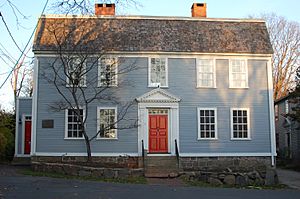John Glover (general) facts for kids
Quick facts for kids
John Glover
|
|
|---|---|
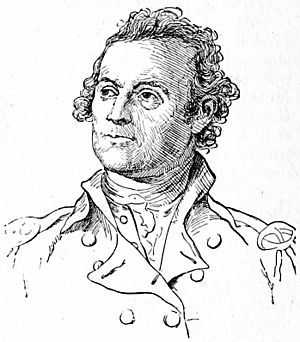 |
|
| Born | November 5, 1732 |
| Died | January 30, 1797 (aged 64) |
| Occupation | Cordwainer, Fisherman, Rum trader, Merchant |
| Spouse(s) | Hannah Gale Frances Fosdick |
| Signature | |
John Glover (born November 5, 1732 – died January 30, 1797) was an American fisherman, merchant, and important military leader. He came from Marblehead, Massachusetts. During the American Revolutionary War, he became a brigadier general in the Continental Army.
Contents
Early Life and Community Service
John Glover was born in Salem, which was then part of the Province of Massachusetts. His father was a house carpenter. When John was only four years old, his father passed away. Soon after, his family moved to the nearby town of Marblehead.
As a young man, John Glover learned to make shoes, a trade called a cordwainer. He also became involved in trading rum. Over time, he grew his business and became a ship owner and a successful merchant. In October 1754, he married Hannah Gale.
After the Boston Massacre in 1770, groups called Committees of Correspondence were formed. These groups helped towns communicate about British actions. Marblehead chose Glover, along with Elbridge Gerry and Azor Orne, to be part of their committee. Later, when the First Continental Congress decided to stop trading with the British, Glover was chosen to help make sure this trade ban was followed.
Military Career and Key Battles
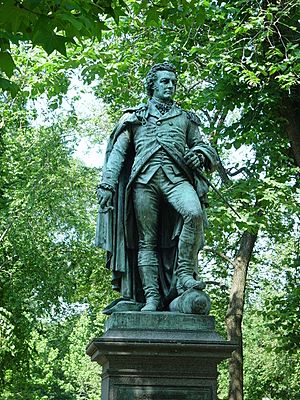
John Glover was active in the local militia for many years before the American Revolution began. His military service started as early as 1759. In 1775, he was chosen as lieutenant colonel of the 21st Massachusetts Regiment from Marblehead. After the death of Colonel Jeremiah Lee in April 1775, Glover became the commander of this unit.
In June 1775, Glover led his regiment to join the siege of Boston. There, General George Washington used Glover's ship, the Hannah. This ship was used to attack British supply vessels. The Hannah was one of the first privateers, which were private ships authorized by Washington to attack enemy ships. Because of this, the Hannah is sometimes called the first ship of the Continental Navy.
Glover's "Amphibious Regiment"
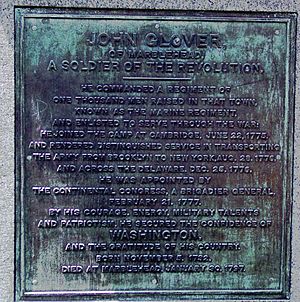
Glover's Marblehead militia became known as the 14th Continental Regiment. This regiment was special because it was made up almost entirely of skilled seamen, mariners, and fishermen. They were called the "amphibious regiment" due to their amazing skills on the water.
After Washington's army lost the Battle of Long Island (also called the Battle of Brooklyn) in August 1776, Glover's Marbleheaders performed a heroic act. They secretly moved the entire American army across the East River to Manhattan Island during the night. This daring rescue saved the army from being trapped by the British.
Glover's regiment continued to fight bravely in the New York campaign. They faced the British at Kip's Bay and Pell's Point.
Crossing the Delaware River
The most famous action of Glover's regiment was helping George Washington's army cross the Delaware River. On the night of December 25, 1776, they ferried the army across the icy river in coal boats. This surprise crossing led to a major victory against Hessian forces at the Battle of Trenton in New Jersey on December 26, 1776. This victory was a huge boost for the American cause. The regiment was disbanded at the end of the year when their enlistments ended.
Glover then returned home to care for his sick wife and manage his businesses. He initially turned down a promotion to brigadier general in February 1777. However, after a personal request from General Washington, he rejoined the war and accepted the promotion. He commanded a brigade of four Massachusetts regiments. He served in the successful Saratoga campaign in 1777 and the Battle of Rhode Island in 1778. For the rest of the war, he was stationed along the Hudson River, guarding against British movements from New York City.
Later Life and Legacy
John Glover's first wife, Hannah, passed away in 1778. In 1781, he married Frances (Hitchborn) Fosdick, a widow. He left the army in 1782 due to poor health and returned to his business interests.
He continued to serve his community in various roles. He was a town selectman and a delegate to the state convention that approved the U.S. Constitution in 1788. He also served as a member of the Massachusetts House of Representatives from 1788 to 1789. He retired to Glover Farm in 1782, which he bought after the war. The farm was on the border of Marblehead and Swampscott. The farmhouse still exists today. John Glover died in Marblehead in 1797 and was buried in Old Burial Hill (Marblehead, Massachusetts).
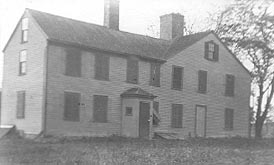
Memorials and Honors
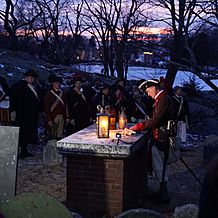
Many places and things have been named in honor of John Glover:
- On November 20, 1783, he was given the charter for the town of Glover, Vermont, in recognition of his service.
- Fort Glover in Marblehead, originally built during the Revolutionary War, was named for him when it was rebuilt during the Civil War.
- The frigate USS Glover (FF-1098) was named after him.
- Glover's Rock in the Bronx is a memorial dedicated to him.
- Glover School in Marblehead was named after him in 1916.
- There is a statue of Glover on Commonwealth Avenue in Boston.
- The General John Glover House is located in Marblehead.
- Glover Field in Pelham, New York is also named for him.
Glover's Regiment Re-enactors
To honor General Glover's legacy, a dedicated group of re-enactors formed for the bicentennial. They continue to participate in special events throughout the year. They commemorate the achievements of Glover and his famous regiment.
Books About John Glover
- History and Traditions of Marblehead by Samuel Roads
- General John Glover and His Marblehead Mariners by George Bilias


